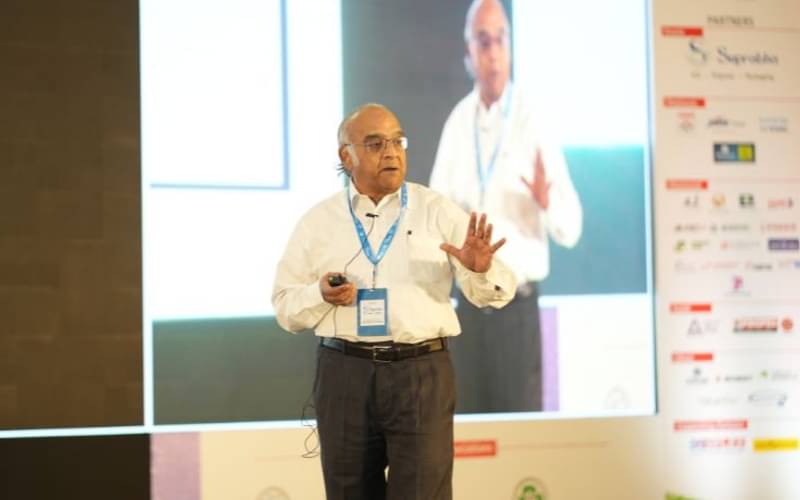Dr S Sivaram: Recycling is not circularity
At the third international ResPack conference in Mumbai, Dr Swaminathan Sivaram delivered a keynote presentation about sustainable packaging in which he highlighted ten challenges in India
12 Aug 2024 | By Abhay Avadhani
In his keynote presentation, Dr Swaminathan Sivaram says, “The crux of the matter is, how does one make polyolefins packaging materials sustainable and circular?” Throughout his presentation, he debunks many myths about plastic. The chief thing being how divisive definitions tarnish the sustainability drive - and how industry bodies are struggling to agree on the terms ‘recycled’ and ‘reuse’, which are creating confusion among consumers. He says, “Conflating re-use economy with circular economy is incorrect messaging.” He points out that material can’t be re-used all the time.
Dr Sivaram addresses the growing problem of plastic waste in the environment. He emphasises that plastic packaging products often have a short life cycle, leading to significant waste generation. This waste, when not properly managed, results in environmental hazards. These hazards include the release of microplastics into water bodies, air pollution, and soil contamination. Additionally, the presence of harmful chemicals used as additives in polymers exacerbates these issues.
One major issue discussed in the presentation was the poor management of plastic packaging waste. Dr Sivaram points out that in many lower and upper middle-income countries, the lack of proper facilities for safely disposing of waste is a huge obstacle. This problem is exacerbated by ineffective laws and bans on plastics that aren't enforceable. While these regulations are meant to help, they often miss the main causes of waste issues and end up putting too much responsibility on consumers. He stresses the importance of creating policies that are practical and based on sound science, benefiting both producers and consumers.
As a Respack delegate said, responding to Dr Sivaram’s presentation during the Q&A session that “reduce, reuse, recycle” is a familiar mantra, but there are sharp disagreements over which to prioritise. Then there is the challenge, that a petrochemical glut has made new plastic cheaper than recycled, with the surge in manufacturing in China and US which has led to oversupply of products such as polyethylene.
As Dr Sivaram says, “Circularity must be economically sustainable. But how does one manage the balance sheet when recycled resin is more expensive than virgin resin; and rPET is 20% more costly.” Under such circumstances, circularity does not offer a value proposition to the consumer.
The complexities in achieving true circularity
Dr Sivaram says circularity means creating products and systems that keep materials in use for as long as possible, which reduces the need for new raw materials and lessens environmental harm. He says that “true circularity” is different from simply reusing materials. “Recycling is not circularity,” he adds. He points out, polyolefins cannot be re-used more than one-two times. You may recycle PP thrice, but you cannot rebuild the molecular weight. The more you recycle polyolefins, the more unfit they become for a circular economy.
Dr Sivaram demystifies advanced recycling techniques like polymer-to-monomer (P2M) recycling and feedstock recycling offer ways to enhance plastic circularity. He says, polymer to polymer recycling is possible, but monomer to monomer recycling is most desirable.
Dr Sivaram explains how P2M breaks plastics into their basic monomers, useful for polyesters and nylons, while feedstock recycling turns plastics into hydrocarbons through pyrolysis. However, these methods require clean, well-sorted waste and are energy-intensive, needing strategic placement near waste sources or monomer production sites to be cost-effective.
Sivaram tells the delegates: The more you recycle polyolefins, the more unfit they become for a circular economy
How a re-think can tackle the plastics paradox
Dr Sivaram tackles the tricky issue of sorting and identifying plastic waste. Plastics exist in so many types and forms that recycling them is complex. Each type of plastic needs a specific processing method, and when different plastics are mixed together, it can really hurt the quality of the recycled material.
Dr Sivaram recommends that if producers were open about the materials they use, it would make sorting and recycling much easier and boost public confidence in the recycling system. He talks about how digital technologies like optical sorters, computer vision, and blockchain could improve waste sorting. However, these technologies are expensive to start with and need global standards to be used effectively everywhere.
He alludes to the fact that our recycling plan (EPR thinks everything is PP) unravels on thorny externalities; and timid half-hearted rules and regulations which don’t solve a broader problem. For instance, obsolete labelling systems and plastic resin codes. He says, “7 is the most abused label and placing a recycling triangle around it is gross abuse. Define the material instead.”
Later, he dwells upon the use of chemical additives in plastics. Dr Sivaram questions whether some additives are necessary for a product's performance. He points out that these additives can create secondary byproducts during recycling, which might introduce new risks. This highlights the need to rethink how we use chemical additives in plastics, not just to ensure safety, but also to make recycling simpler. “Some of the products have a short shelf life of 30 minutes, then why does the plastic packaging for such a product need an additive that enhances it to five years. It’s not logical,” Sivaram adds.
Dr Sivaram’s presentation at Respack was an eye-opener. He tells the delegates in a blunt non-nonsense tone that “Technologies are evolving but technologies are expensive. And investments in such technologies may not be supported by the slender margins in waste processing.” He says the plastics economy is opaque and fragmented plus there are too many vested interests. And so, Dr Swaminathan Sivaram goads the delegates to adopt a multi-faceted approach that combines technology with innovation - and seize the moment.
As team WhatPackaging? overheard from an industry veteran that the packaging industry must prepare for tougher rules. Quite true. And who better than those who helped to enable plastic consumption to show us a way beyond it?



